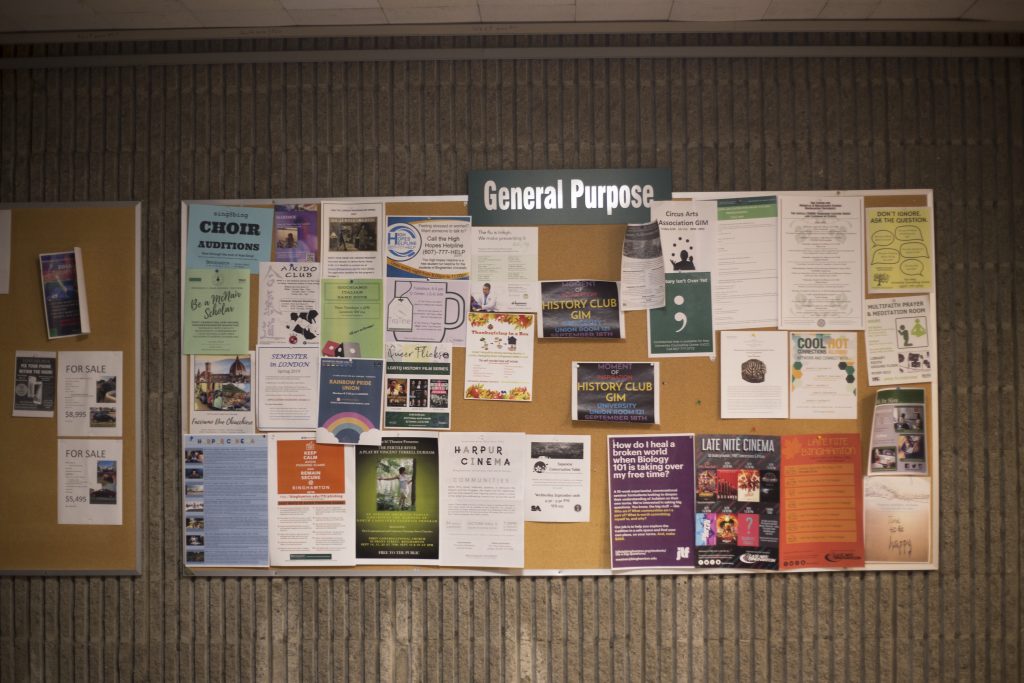
With new bulletin boards around campus, Binghamton University is changing its posting policy and allowing students to hang posters unrelated to academics, events, housing and items for sale, a move that is intended to increase opportunities for students to exercise freedom of speech.
The changes follow last semester’s protests at the University Downtown Center (UDC), which were sparked after police responded to students hanging flyers in the building. The flyers were intended to condemn racism on campus. According to police, the students were violating the University’s posting policy of the time.
According to Ryan Yarosh, senior director of media and public relations at BU, the policy was updated after a committee was formed in the spring of 2018 to review and change the original posting policy.
“The new policy was recently implemented and necessary after reviewing the former policy which was outdated, lengthy and somewhat challenging to interpret,” Yarosh wrote in an email.
The committee consisted of five people, including Yarosh and Nicole Sirju-Johnson, director of the Multicultural Resource Center and interim chief diversity officer. Staff also looked for student feedback. Conrad Taylor, ‘18, a communications assistant at BU, worked with the committee as a student last semester. He wrote in an email that the updated policy will help individual students and organizations convey their messages more readily.
“The University’s new policy is clear, straightforward and sensical,” Taylor wrote. “I’m happy to see Binghamton taking proactive steps in addressing an outdated policy, and in turn creating a new policy that can help all students, from club presidents trying to recruit new members, to activists trying to spread their message.”
According to the updated posting policy, flyers can be posted on events, housing or newly created general-use bulletin boards, but cannot be posted on office and departmental boards. Additionally, flyers cannot be posted on walls, doors, painted surfaces, windows or ceilings. Students are permitted to use water-soluble chalk on uncovered pavement and concrete sidewalks.
Although there are no guidelines on exactly what can be posted on the general-use bulletin boards, students are required to adhere to the Code of Student Conduct while posting, which prohibits students from targeting groups or individuals based on race, gender or sexual orientation.
According to Yarosh, the updated policy is meant to create an environment in which students can readily express their agendas.
“The below-posting policy has been designed to promote the free exchange of ideas and assist sponsors in more effectively promoting their events and make event information more readily accessible to the campus community,” Yarosh wrote. “It should be noted that this policy requires the cooperation of the entire campus community to be successful.”
Some, like Kalissa Sawyer, ‘18, a case worker and outreach coordinator at the American Civic Association, believes the policy does not effectively address the issues of racism on campus and the administration’s response that students brought up last semester. Sawyer, who participated in the protests at the UDC last semester, said she believes the policy is still restricting freedom of speech.
“It also just refers to the posting policy being about ‘events’ and says nothing about the kind of posting we did, which was completely about bringing awareness to the environment of ongoing racism and [the] indifference of the Binghamton administration in effectively addressing it and truly listening to the problems people of color face,” Sawyer said.
According to Sirju-Johnson, the committee looked at the original policy and the history behind it in an effort to provide more opportunities for expression. Sirju-Johnson said that being part of a community comes with responsibilities.
“However, I urge campus constituents to remember the saying that ‘to whom much is given, much is required,’” Sirju-Johnson wrote in an email. “In short, there is a great deal of responsibility that comes with expression of ideas that takes the entirety of the community and campus into account.”


